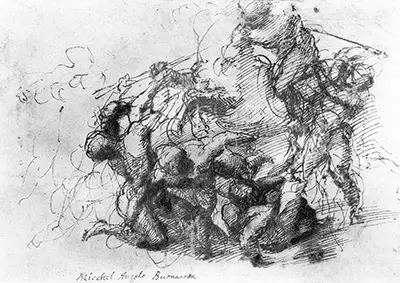The painting was commissioned to be displayed at the Palazzo Vecchio in Florence but other projects would drag Michelangelo away and he never managed to actually commence the final piece. There are at least a dozen different study drawings left over which help us to understand just what he had in mind, as well as a more complete drawing from Aristotele da Sangallo, a pupil of the artist, which appears to indicate the overall composition in a more complete manner. There are unfortunately a number of artworks from the great Renaissance masters that were either left unfinished or later lost or destroyed. Thankfully, all that survived to the present day is preserved with care and attention, with its long term condition made a priority.
Piero Soderini, statesman of the Democratic of Florence had desired this piece because it celebrated the victorious Florentine army in a battle against those of Pisa in 1364. It may seem strange today to talk about Italian provinces fighting against each other but this was particularly common during the time of the Renaissance, where the map of Europe was significantly different and certainly more fractured than it is today. There were also forces from abroad that would become embroiled in Italian affairs which further complicated issues. Soderini wanted the completed painting to fill a wall within the Salone dei Cinquecento in the palace, with another work from Da Vinci planned for the opposite wall, with his Battle of Anghiari. These types of rooms devoted to battle scenes are actually fairly common, with Eugene Delacroix helping out in the French romanticist era to construct something similar from the French perspective.
Elements of the overall composition also remind us of the later work found in French art. The Romancists would focus on battles within their careers because of the incredible emotions that can be harnessed within this type of content. They would also capture scenes at sea, where groups of sailors would be caught in peril by the power of nature, again creating an atmosphere of extreme tension and energy. Examples from that period which might compare to Michelangelo's Battle of Cascina would be Raft of the Medusa by Theodore Gericault and Liberty Leading the People by Eugene Delacroix. Both artists would have also studied the work of Peter Paul Rubens who consistently implemented scenes of activity and tension within his career and was influential on a several generations of European artists from a number of different art movements.


